Creando una Gacha fuerte: cómo los profesionales se aseguran de que los duplicados no sean "malos lanzamientos"
Debido a la controversia de Star Wars Battlefront II, la industria está analizando mucho más de cerca qué prácticas de monetización son éticas y si la industria puede controlarse a sí misma o necesita más regulación para evitar el uso indebido.
Mientras tanto, es probable que las cajas de botín sigan apareciendo en gran medida en las listas principales, ya que el potencial de ingresos de gacha y las cajas de botín es difícil de ignorar. El uso de un sistema de caída aleatoria ha permitido que florezcan muchos géneros nuevos y bucles principales.
Sin embargo, diseñar para gachas no es un proceso de diseño sencillo. No todos los géneros ni todos los tipos de juego pueden adaptarse para admitir un diseño de caja de botín. Ya hemos hablado de algunos de los ingredientes necesarios:
- Parte 1: Garantizar que su sistema gacha tenga suficiente profundidad para soportar caídas a lo largo del tiempo
- Parte 2: Garantizar que su sistema gacha tenga suficiente ancho para garantizar que cada gota sea útil para un jugador
Ahora es el momento del tercer elemento: cómo manejar los duplicados. Es lo que llamamos un caso límite, pero es un proceso que definirá cómo se sentirá tu juego a largo plazo: ¿Sienten los jugadores que los duplicados son útiles o inútiles?
Duplicados frente a malas caídas en un sistema Gacha
Lo primero que hay que dominar cuando se trata de un sistema gacha es cómo pensar de manera diferente ante dos situaciones que pueden surgir; duplicados y malas caídas.
Por ejemplo, supongamos que tenemos un sistema Gacha similar a Overwatch: nuestras cajas solo arrojan artículos cosméticos. Como resultado, cada elemento que arrojamos es permanente (el jugador lo conserva para siempre y no puede "consumirse") y los jugadores buscan los elementos cosméticos que desean para los personajes con los que interpretan.
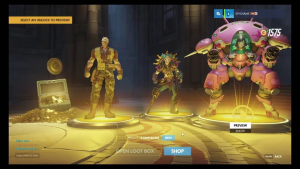
En este sistema, un 'bad drop' podría ser un objeto cosmético para un personaje con el que no juego ; tal vez en el futuro lo haga, pero durante el tiempo que llevo jugando no me ha gustado el personaje. pregunta. Como tal, esta es definitivamente una mala caída.
Idealmente, debería poder convertir este artículo en algo de valor para eventualmente poder obtener los artículos que quiero. En juegos como Overwatch y Hearthstone, esto significa convertir cualquier caída mala en una moneda de polvo, que te permite comprar los artículos que deseas directamente.
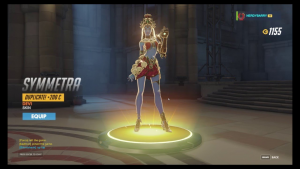
Sin embargo, también son inherentes a este sistema los duplicados. En esta situación, recibo el mismo objeto cosmético para un personaje que ya tengo, lo que parece una gran pérdida. Es doblemente frustrante si el juego arroja un duplicado de alta rareza (es decir, un aspecto legendario), ya que se siente como un desperdicio enorme: tuve la suerte de recibir un artículo legendario, pero la mala suerte de que fuera un artículo que ya había aparecido antes.
Como se sugirió anteriormente, juegos como Overwatch y Hearthstone manejan esto permitiendo a los jugadores convertir estos elementos en polvo, esencialmente tratando un duplicado de la misma manera que una mala caída . Sin embargo, la cantidad de polvo que se arroja es una fracción del costo de comprar el aspecto que deseas directamente, por lo que los jugadores aún se sienten fatal cuando obtienen un duplicado.
Como resultado, Overwatch finalmente hizo público el ajuste de la lógica de caída para evitar duplicados tanto como fuera posible , mientras que Brawl Stars incluso eliminó los duplicados por completo . Sin embargo, en mi opinión, no tiene por qué ser así. Eliminar duplicados de su sistema reduce la profundidad y ejerce más presión sobre su equipo para desarrollar más contenido. Lo ideal sería que los jugadores celebraran los duplicados, haciendo de este raro suceso algo valioso, en lugar de servir como un resultado lamentable.
A la luz de esto, veamos cómo desarrollar mejores mecánicas de duplicado de Gacha:
Seis mecánicas para manejar duplicados
#1 Los duplicados no son duplicados
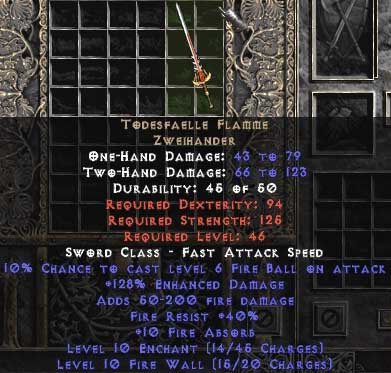
Una forma diferente de evitar el dolor de los duplicados es asegurarse de que rara vez se produzcan duplicados .
Una forma de hacerlo es hacer que cada contenido se genere de muchas maneras sutilmente diferentes. Por ejemplo, un arma o un personaje pueden caer, pero ciertos subelementos se aleatorizan y generan.
Con este método, si cae un elemento duplicado, los jugadores pueden hacer comparaciones más pequeñas entre las caídas . Esto se hace cuando el equipo o las entregas se generan de forma procesal y aleatoria y hay suficientes estadísticas detalladas más pequeñas que los jugadores desean optimizar activamente.
Por ejemplo, en el primer Destiny, podías obtener la misma pieza de equipo muchas veces.
Sin embargo, cada caída tenía estadísticas aleatorias y ventajas asociadas, lo que provocó que los jugadores se lanzaran a una persecución al final del juego para encontrar equipos inusuales. El juego incluía ventajas que compensaban el problema de que algunas armas fueran dominadas en modos competitivos como The Crucible. Si bien esto obviamente se fue por la borda y causó graves problemas de equilibrio, esto muestra el poder del equipo generado por procedimientos: profundiza la persecución y hace que los duplicados sean algo que los jugadores buscan activamente.
Sin embargo, este sistema puede hacer que los jugadores terminen con montañas de armas y equipo que no quieran usar. Como resultado, los diseñadores necesitan encontrar formas de convertir todas las malas caídas en algo útil para los jugadores, como por ejemplo:
- Oro para comprar más armas.
- Dust to re-roll the weapon perks of your choice
- Resources to upgrade the weapons that the player actually wants
While such solutions put the duplicate issue to bed, it also puts more pressure on the bad drop system.
#2 Repair
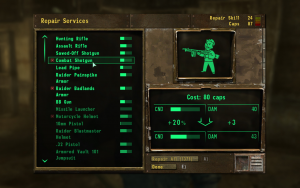
One system that hasn’t been used often is the repair system..
Fallout 3 used this effectively by asking players to collect duplicates to maintain their gear. Have an amazing piece of gear? It will eventually deteriorate and be less effective over time. To repair it, you can pay a large amount of currency or find duplicates of your gear to repair for free. If the deterioration is felt as fair to players, this can create a repeatable grind to find duplicates of your gear to maintain its highest possible gameplay effectiveness.
This system is likely avoided because of the consumable feel that drops from the gacha become: The feeling that an amazing item will drop, but one that’s only useful briefly. It’s a feeling that anyone who played Zelda: Breath of the Wild will definitely find familiar
#3 Fusion (Unlocking Potential)
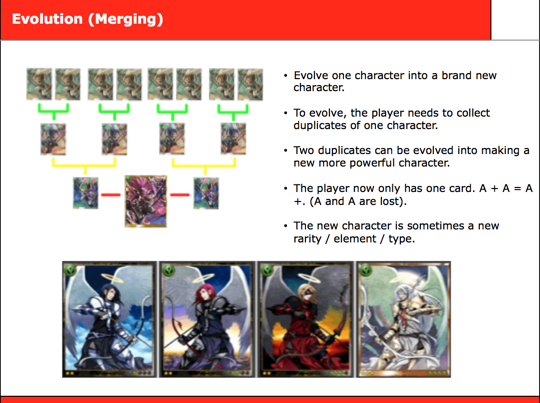
[Source: Both Guns Blazing]
Fusion is the typical way that Japanese and Chinese games have made duplicates relevant. These games typically focus on selling stat improvements over cosmetics, and because of this they focus their duplicate mechanics more on unlocking higher stat growth.
Fusion mechanics are designed in a way that requires the player to receive a duplicate in order to increase the stat potential of a card. As such, while you can upgrade a card up to high level, unlocking the ability to upgrade it even further requires you to “evolve” or “awaken” the card with a duplicate of itself.
When looking at the stacking probability needed to get the highest star rating, it’s easy to see why they do this. You can drive a lot of depth in a gacha system by asking players to chase after duplicates without adding more content.
The problem with this comes in the randomness of the system. Getting a single duplicate becomes so important in this system that players can become very frustrated. Players have no grindable path to unlock the potential for their favourite characters. Hence, designers came up with a new system: Sharding.
#4 Sharding
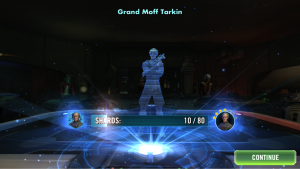
As duplicate systems changed over time, there was a need to make them more flexible and granular.
To solve the issues of fusion, gacha games started to experiment with shards instead of duplicate fusion, best seen in Western Gacha games like Galaxy of Heroes. With shards, each character can’t be unlocked until you have collected a certain amount of shards. In the above example, Grand Moff Tarkin requires 80 shards to be unlocked.
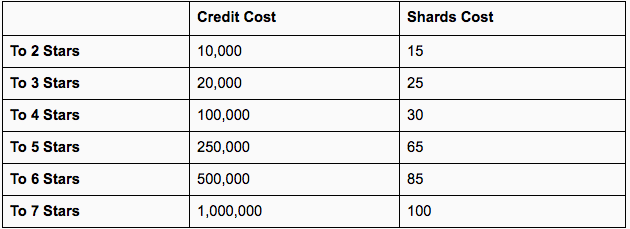
However, that’s just to unlock the character. To upgrade the character to its maximum potential, the player would need to collect additional shards, so “duplicates” are simply just additional shards needed to progress to the maximum potential.
With characters now needing hundreds of shards instead of single drops to reach the maximum characters, games added mechanics which allowed players to grind for specific shards, so players that are looking to upgrade or unlock their favourite character could grind specifically for it. This wasn’t possible with the fusion system before, since giving a single card could mean massive progress for players. In short, sharding allows clear progress.
However, there remains one big problem: opening up a gacha pack you’ve paid for and receiving mere pieces of a character – nothing that you can use there and then. It’s a transaction the player almost always regrets and, as a result, Supercell came up with a workaround.
#5 Unlock Upgrade
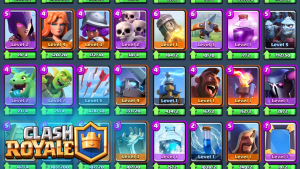
Clash Royale provided a completely new framework for how to handle duplicates. It took the best of the Shard framework, made the handling of duplicates restrictive, yet still has a gacha system that feels fair.
With Royale’s system, each card is unlocked after getting the first card. This feels far better than shards because getting a new card feels amazing – there’s no more paying for “parts of a character”.
After you unlock the card, the card becomes a duplicate sink. In order to upgrade the card, you need to collect a number of duplicates of that card. It removes any needed management of duplicates, while giving a clear path for players to upgrade their cards.
Due to the design, players will unlock cards fairly quickly (you only need one card), but the majority of the chase is after the (thousands) of duplicates necessary to upgrade your cards to a competitive level. This system has significant depth, allowing Supercell to be generous with the cards it gives out, and keep players collecting for years.
However, despite its perks, this design still has disadvantages. For one, Clash Royale has to work really hard to try to ensure that as many cards as useful to players as possible. Otherwise, getting a duplicate for a card you aren’t using is completely useless (the only way to get value from it is to trade it away to clan mates). This works very well for CCG style games, but many games can’t support this level of gacha width – where every item from the gacha is theoretically useful.
#6 Unlocking Better Cosmetics
All these mechanics thus far are primarily focused on handling situations where duplicates give out better stats – they “unlock the potential” of an item so they can be upgraded further. This works great for games that are RPG-based and are comfortable with players speeding up progression (ex. Clash Royale), but most competitive PvP games can’t do this, such as Playerunknown’s Battlegrounds, and League of Legends. Competitive PvP games can really only sell cosmetics. So, how do you add value to duplicates for cosmetic economies?
This is considerably harder, which is why most cosmetic driven games end up allowing players to convert duplicates into dust (ex. Overwatch) or allow players to sell them on a secondary market (ex. Counter Strike: Global Offensive). League of Legends has even dabbled in at first not fully “unlocking” the cosmetic, but only allowing the player to “rent” the cosmetic. Getting duplicates eventually allows the player to convert their duplicates into a permanent item.
However, beyond this, the only thing you can do is make duplicates of cosmetic gear unlock cooler/better visuals of a cosmetic item. In Counter-Strike: Go (CS:GO), they use a “decay” system to do this.
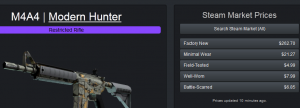
In CS:GO, each item is dropped with a randomly assigned “decayed” attribute. This could mean that the item looks brand new, or is heavily worn down. Getting a duplicate allows players to find items which have far less wear, meaning that players aren’t just chasing that “item”, but also chasing the best looking version of it. The visual differences between “Factory New” and “Battle Scarred” are striking – making the value of having the highest valuable version of the item very important to players that are chasing after cosmetics.
As such, similar to stats, cosmetics can have a “unlocking potential” of their own – you just need to make sure your cosmetic items can have varying degrees of visual quality.
Summary: Duplicates aren’t Bad Drops
In any Gacha system, regardless if you’re just dropping cosmetic items or gameplay impacting items you, as a designer you are responsible for ensuring that there is as little remorse or regret from players – for making sure that each purchase of a loot box feels rewarding to players.
- Gacha depth helps ensure that you can sustain drops from a gacha.
- Gacha width ensures that each item is as useful as possible.
- However, Duplicates are inevitable, and how you handle them is important to achieve the balance between a system that feels fair to players and doesn’t cripple your studio by producing lots of content.
There are seven examples of mechanics you can use to handle duplicates and give them value:
- Dust: Allowing players a path to purchase items they want
- Los duplicados no son duplicados : uso de generación de procedimientos para tener diferencias sutiles entre gotas
- Reparación : los duplicados pueden potenciar un artículo que ya se tenía
- Fusion : desbloquear más potencial
- Fragmentos : dividir la fusión en un camino más granular
- Desbloquear y actualizar : desbloquear niveles de estadísticas más altos con duplicados, sin opción para duplicados
- Desbloqueo de mejores cosméticos: desbloquear versiones más atractivas del mismo cosmético
Cada uno tiene sus pros y sus contras, pero esperamos que puedan ayudarte a decidir cuál es el mejor camino para tu juego.
Leave a Reply